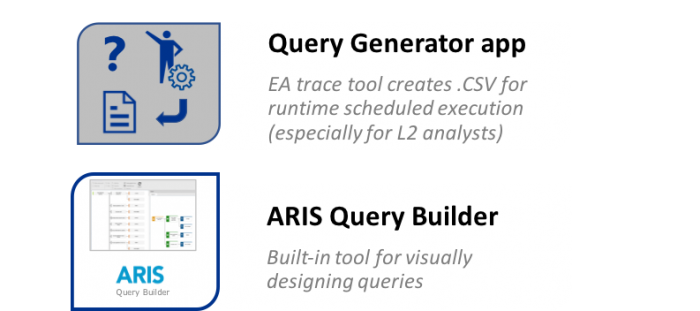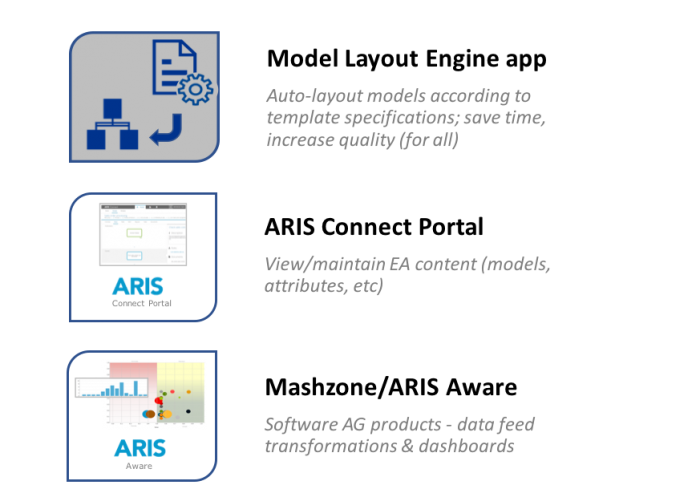PART 2: Making it work: People & toolchain
- Discussion about:
- [x] "EA as a service" based approach
- [x] People
- [x] Tools
- For:
- EA program manager
- EA Architects
- EA Analysts
- IT DevOps managers
In part 1, we looked at techniques to define and answer questions using a service based approach and people's roles. Part 2 of our series will have a closer look at the people, and the setup of the EA toolchain to make a service-based approach happen.
Part 3 will apply the concepts in part 1 and 2 in the context of a controls-readiness case study, where we attempt to determine systems that pose the highest risk to passing an audit.
Getting back to our original problem scenario: evaluation of a system portfolio using a set of customized criteria. To answer the important "business problem", we might need to:
- Wire (out of scope for this article). Revise our architecture "method" – the standardized terminology and way things are connected, and how levels of detail are defined
- Create (out of scope for this article). Collect, normalize, validate content
- Crunch, flatten. Analyze the content using various methods, such as EA built-in query tools, or custom applications built in that platform
- Present. Visualize the content, in a way that is appealing for the consumer (i.e., creating a dashboard)
While items (1) and (2) are outside the scope of this discussion, steps (3) and (4) are key to leveraging EA content and views to deliver on key services: crunch, flatten, present.
The toolchain. In the following section, we describe how to crunch, flatten, and present using a mix of built-in tools and custom apps, using Software AG tools. In our scenario, we will use icons to represent "out-of-box" (OOB), and custom-developed tools.
![]() Out-of-box" tools, such as Software AG’s Mashzone (dashboard) and ARIS (EA/BPA modeling and analysis tool)
Out-of-box" tools, such as Software AG’s Mashzone (dashboard) and ARIS (EA/BPA modeling and analysis tool)
![]() Custom ARIS JavaScript toolchain (re-usable apps that "plug in" to the ARIS API, using open-source components)
Custom ARIS JavaScript toolchain (re-usable apps that "plug in" to the ARIS API, using open-source components)
The steps and relevant toolchain components are:
- Crunch. Use a mix of custom-developed ARIS JavaScript apps and standard out-of-the-box tools.
- Flatten. Use a mix of custom apps and OOB tools. While the built-in standard ARIS query tool can help to easily create simple queries, they are not useful as scheduled reports or for running high-volume analysis. Furthermore, the OOB report editor cannot do advanced things such as auto-create web portal links, automatically send an email, or use complex filtering criteria. To "close the gap", a custom JavaScript utility (Query Generator) has been built by an L5 developer (especially for L2 analysts):
- Present. Use a mix of custom apps and OOB tools. For example, the custom app built by an L5 developer ("Model Layout Engine") uses layout algorithms to automatically arrange any number of "messy" modeled objects into profile-driven, architecture-layered layouts.
For our case study (in part 3), this combination of the toolchain will realize a decision-making (dashboard), end-to-end. To make this work -and reiterate what was said above- an important assumption is that the content already exists in the repository (for example, all applications have necessary attributes maintained, with a high degree of quality).
Then, we will crunch (summarize), flatten, crunch (transform), and present:
In the context of this example, the "tech" people-skills needed to operate (not develop) that toolchain are as follows:
We do not need "heavy" L3-5 developers for this kind of low-to-medium complexity dashboard. The combination of this set of tools and corresponding training means that any analyst-type person can be trained to wire, create, crunch, flatten, and present decision-ready information.
Enabling L1/L2 analysts in this way to allows us to scale operations (i.e., "create 10 dashboards next month") faster, at low cost, and with stronger business experience.
Continue to Part 3
For questions or to discuss how you can more effectively leverage your Enterprise Architecture capability, please comment below or e-mail the author below.
Michael Idengren, Agile Architect
KPMG CIO Advisory helps your organization deliver EA value in the context of IT/operations efficiency, process improvements, technical solution assessments, and "strategy-to-implementation" digital transformation program governance.


%20(hi-res).png)
.png)


.png)
.png)